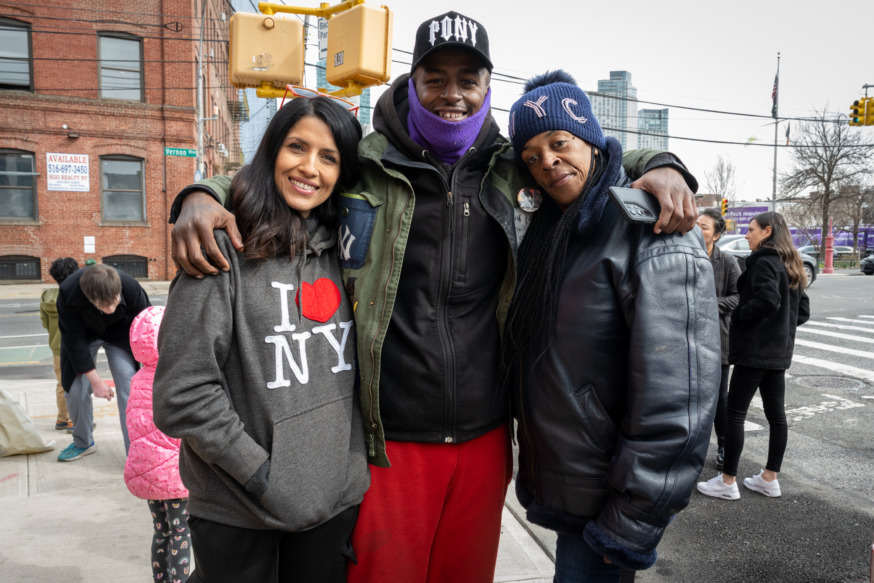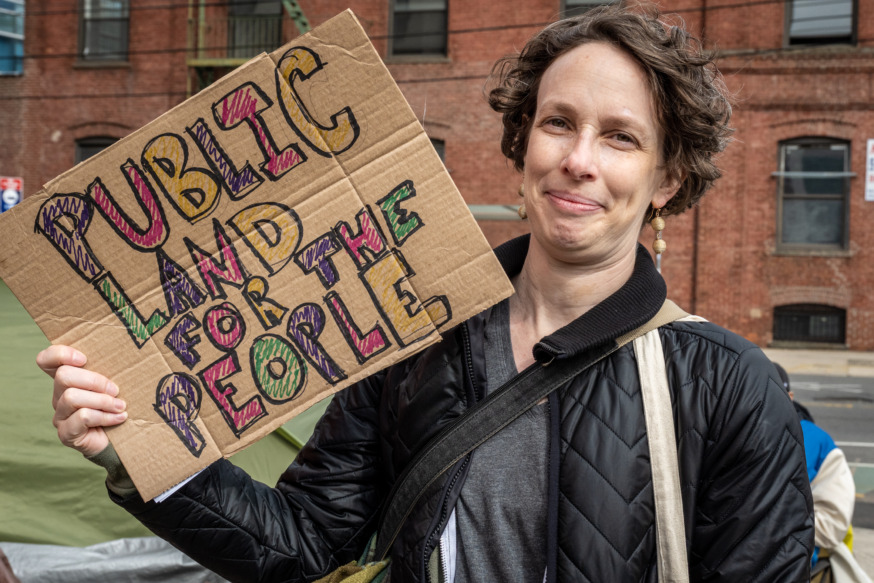
Lashawn “Suga Ray” Marston with his girlfriend Luciann Berrios and mom Kim Marston on Sunday, March 12. (Photo by Gabriele Holtermann)
March 13, 2023 By Gabriele Holtermann
Members and allies of the Western Queens Community Land Trust (WQCLT) showed their love for fellow member Lashawn “Suga Ray” Marston at a solidarity rally outside the NYC Department of Education (DOE) building at 44-46 Vernon Blvd. in Long Island City on March 12.
Marston has been on a two-week, one-man hunger strike since Feb. 28, during which he has slept in a tent outside the publicly owned building to garner the attention of Mayor Eric Adams. Marston told Queens/LIC Post that he started the hunger strike because he wants Adams to turn the underutilized building into a community facility.

Lashawn “Suga Ray” Marston embraces his girlfriend Luciann Berrios. (Photo by Gabriele Holtermann)
Marston’s mother, Kim Marston, first thought her son was “nuts” when he told her he was going on a hunger strike, mainly because she was concerned for his safety. Her concerns stem from Marston’s prior life hat involved the streets and drugs. In 2003, Lashawn was shot multiple times. During a three years prison term he decided to turn his life around, becoming a successful artist and prominent community activist.
But she was also brimming with pride thinking back how far her son has come since then, determined to improve his community.
“I’m looking at my son, and I see that he is really sincere,” Kim Marston told Queens/LIC Post. “He’s not playing a joke. It’s not Fantasy Island. He is serious, and all he’s doing is trying to reach out for help again, not for him, for all of us. We are all here for a purpose, and some purposes just a little more intense than others. And I feel that one of his purposes are for the people.”
Frank Brown, one of Marston’s friend, brought a tent on March 11 and spent the night camping alongside Marston in solidarity.
Brown, a member of the Northeast Political Prisoner Coalition and the December 12 Movement, said he wanted to do more than just share Marston’s hunger strike journey on social media. Brown wasn’t surprised that Marston had taken this drastic measure.
“Once he puts his mind to doing something, he’s going to do it, and it’s always about the people,” Brown said. “He makes sacrifices for the greater good.”

Community members came out for a solidarity rally in support of Lashawn “Suga Ray” Marston. (Photo by Gabriele Holtermann)
Long Island City has seen an influx of luxury developments. But the gentrification has come at a cost, threatening the neighborhood’s culture and economic prospects of long-time and low to middle-income residents.
The DOE, which occupies 40% of the 600,000-square-foot building, would remain as a tenant and partner. The WQCLT would like to turn the remaining space into a hub for affordable manufacturing, food, and nutrition resources, offer low-cost production space, studios for artists and musicians, a rooftop garden, a commissary kitchen for street food vendors, a food co-op, and more.
Alka Mansukhani has lived in the neighborhood for 30 years and is a member of the Long Island City Coaltion. She feels that public land should be for public use.
“We all are for community land trusts,” Mansukhani said. “So I said, ‘Yes, I have to come out and see what’s happening.’ He decided to do it on his own to make a point, and we need more people like that with loud voices.”

Lashawn “Suga Ray” Marston addresses his supporters at a solidarity rally. (Photo by Gabriele Holtermann)
Dannelly Rodriguez, an Astoria native and housing and civil rights activist, shared that 600 properties worth $4.4 billion were purchased in New York City last year, with a majority of the properties being located in Long Island City and Astoria.
“I want to highlight that because it shows that our home, our community, the space that I grew up in, the space that Sugar Ray grew up in, the space that many of us live in to this day, where we build our families, and our communities and our relationships has become a speculative market for developers and their cronies in office,” Rodriguez said.
A land trust would protect the community from speculators, Rodriguez argued.
“The Western Queens Community Land Trust takes away the speculation of property,” Rodriguez explained. “They can’t say that it’s time to sell for profit because the community has the final say, and we say public land for public use.”
City Councilwoman Julie Won, who represents Long Island City, Sunnyside, Astoria and Woodside, also stopped by. She had already visited Marston a few times during his hunger strike.
“I think it’s incredibly memorable for someone to actively decide that they will experience hunger,” Won said. “They will actively experience homelessness in solidarity with those who are experiencing it. Without agency, without having a choice.”

Councilwoman Julie Won visited Lashawn “Suga Ray” Marston on March 12. (Photo by Gabriele Holtermann)
Won also believes that public land should be used for public good.
“There are a lot of community members who want to see this building use for public use,” Won said. “And I think their plans are good.”
The WQCLT was founded in the wake of the Amazon battle to prevent the building from being sold to another corporation.
“We saved [the DOE building] from Amazon,” Memo Salazar, co-chair of WQCLT, explained. “But now what? When is there gonna be another corporation or Google or Facebook or some giant corporation who wants to take this, and then the city or the state will just make a deal with them and hand them over this public building?”
Jenny Dubnau, who also co-chairs WQCLT, said that WQCLT was up against a lot because real estate companies ran the city.
“Unfortunately, I think our mayor so far has shown that he is kind of a friend of real estate,” Dubnua said. “It would be really great if he could show that he actually has some empathy and care for communities and do some community based development rather than always luxury, pro real estate development. I think it remains to be seen what he will do.”
Marston’s hunger strike is scheduled to end on March 14, his 39th birthday. For him, the building at 44-46 Vernon Blvd is a symbol of what is possible when community comes together.
“In our lifetime, right now, we can see a movement of public land being repurposed for public duty to the people who have the most invested in their community,” Marston said.






